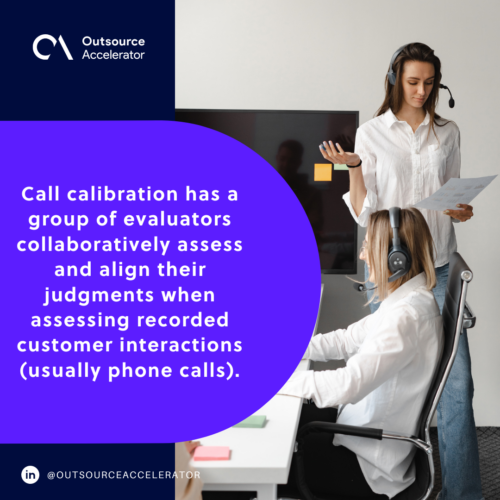Elevating customer interactions with call calibration

Exceptional service over the phone is crucial for any business that relies on customer interactions. Call calibration, a systematic process of evaluating and aligning call quality and content plays a vital role in this.
By conducting calibration sessions, call centers can identify areas of improvement, provide feedback to agents, and create a standardized communication style.
Whether you want to improve customer service or enhance your brand reputation, this article will provide valuable insights and actionable tips to optimize your call process.
What is call calibration?
Call calibration has a group of evaluators collaboratively assess and align their judgments when assessing recorded customer interactions (usually phone calls). It’s a structured process in customer service and sales environments.
The objective is to establish a shared understanding and consistency in evaluating interactions based on predetermined criteria.
By involving experienced agents, supervisors, and quality assurance specialists, call calibration can accomplish the following:
- Reduce subjectivity and bias
- Enhance evaluation accuracy
- Provide actionable feedback for continuous improvement

Call calibration vs. Call monitoring
Call calibration and call monitoring serve distinct purposes within customer service and sales contexts. Both processes contribute to improving customer interactions and agent performance.
| Call calibration | Call monitoring | |
| Focus and purpose | Focuses on achieving consensus on evaluating customer interactions | Focuses on evaluating agent performance |
| Collaboration/supervision | Collaborative effort among evaluators | Handled by supervisors or quality assurance teams |
| Evaluation criteria | Evaluators collectively agree on predefined criteria | Supervisors focus on adherence to company policies, script usage, and other performance-related criteria |
| Feedback and improvement | Generates insights used to align evaluations | Generates insights for agent coaching and training |
| Frequency | Conducted on a scheduled basis, like monthly or quarterly | An ongoing process, conducted in real-time |
| Impact on agents | Ensures evaluators have a common understanding | Provides individual feedback |
Steps of the call calibration process
The call calibration process is a systematic approach used to ensure consistency and accuracy.
The process typically involves the following stages:
Identifying participants
Select participants who will take part in the call calibration sessions. These individuals would have a solid understanding of the company’s customer service and sales standards, as well as the ability to provide constructive feedback.
Preparation
Gather a representative sample of recorded customer calls. These calls should encompass various scenarios, types of interactions, and customer segments.
These samples should also be anonymized to ensure objectivity and fairness during evaluation. Prepare clear guidelines, criteria, and evaluation forms to assist participants during the assessment process.
Conducting the calibration session
This step concerns the bulk of the call calibration process. Participants are introduced to the purpose and goals of call calibration.
The importance of consistent evaluation and its impact on customer satisfaction and business outcomes is also emphasized.
The stages of this part include:
- Playing recorded calls – Recorded calls are played and evaluated individually based on the predetermined criteria. Criteria include agent professionalism, information accuracy, empathy, and script adherence.
- Scoring and discussion – After evaluating each call, participants provide scores and feedback on different aspects of the interaction. Participants discuss and compare their evaluations, share insights, and identify areas of agreement or disagreement.
- Addressing discrepancies – Should there be a case of differing opinions, a conversation is held to understand the perspectives and rationale behind the judgments. This dialogue aims to reach a consensus and improve evaluation alignment.
Evaluating results and providing feedback
The participants compile and analyze all their scores and feedback. They identify common trends, strengths, and areas for improvement across the evaluated calls.
Evaluators highlight specific examples of exemplary customer interactions and instances where improvement is needed. These latter insights serve as the basis for targeted coaching and training efforts.
Implementing actionable improvements
Now armed with the feedback and insights gained from the call calibration session, managers can target training and provide coaching to agents. This helps them enhance their skills and align with company standards.
They also share with all agents any successful examples observed from the calibration. This promotes the adoption of effective communication strategies and techniques.
Ongoing calibration and feedback loop
Organizations should schedule call calibration sessions on a regular basis. This helps maintain consistency in evaluations and ensures ongoing improvement.
Over time, evaluators also refine evaluation criteria and guidelines. The industry is dynamic, and they need to adapt to changing customer needs, industry trends, and feedback.
Best practices for effective call calibration
Implementing effective call calibration practices is crucial for ensuring consistency and quality in customer interactions.
Here are some best practices to help you achieve accurate and beneficial call calibration:
Establish clear calibration guidelines
Before you start the process, it’s important to establish clear guidelines for what constitutes a successful call. Well-defined guidelines are essential for effective call calibration.
These guidelines must outline the specific criteria and parameters evaluators will use to assess calls.
Include factors like:
- Tone of voice
- Accuracy of information
- Empathy
- Adherence to scripts
- Problem-solving skills
These factors should all be part of your calibration process so that every team member has the same expectations and can be held accountable accordingly.
Include diverse participants
The more diverse the group, the better.
Diverse teams can provide insights into customer needs that may not come from just one individual or team. This should encompass experienced agents, supervisors, and even representatives from other departments.
Diverse perspectives bring a broader range of insights to the table, reducing bias and enhancing the overall quality of evaluations.
Including a mix of tenured and newer agents also helps ensure that evaluation standards remain relevant and fair.

Regularly review and update criteria
The criteria used for call calibration should not remain static. Regularly review and update these criteria to align with changing customer expectations, business goals, and industry trends.
The same goes for changes in your pricing and other policies. If these factors change frequently enough, they should be included in regular reviews of your call calibration criteria.
Flexibility in criteria allows the calibration process to remain relevant and responsive. Thai ultimately leads to more accurate evaluations and effective feedback.
Encourage open dialogue
Foster an open dialogue among your agents during call calibration sessions.
Encourage participants to discuss their evaluations, share insights, and ask questions. Ensure that everyone has a chance to participate to get the most out of the conversation.
When evaluators collaborate and openly share their perspectives, it becomes easier to identify areas of agreement or discrepancy. Constructive conversations lead to better consensus-building and accuracy.
Provide targeted training and coaching
Use the insights gained from call calibration to develop targeted training and coaching programs. Design training modules to enhance specific skills.
Ensure all agents are trained the same way so that everyone is consistently effective. Managers should also provide coaching and feedback to agents during and after each session.







 Independent
Independent




